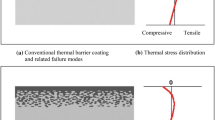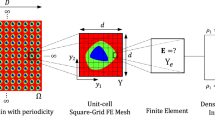Abstract
The propagation of phase boundary in a material undergoing shock induced irreversible phase transition is studied theoretically using a model based on simple-mixture rule. It is found that along with the decay of the phase boundary, a functionally graded material (FGM) forms in the mixed-phase region. Such FGMs are composed of parent phase and product phase, and the composition and physical properties are changing continuously without apparent macro-interfaces. The effect of stress boundary conditions on formation of the FGM is investigated in detail with a numerical method. The possibility of producing FGMs with impact method is proposed and the limit of this method is discussed.
Similar content being viewed by others
References
Suresh S., Mortensen A. (1998). Fundamentals of Functionally Graded Materials. The Institute of Materials, IOM Communications Ltd., London
Czubarow P., Seyferth D. (1997). Application of poly(methylsilane) and Nicalon polycarbosilane precursors as binders for metal/ceramic powders in preparation of functionally graded materials. J. Mater. Sci. 32:2121–2130
Tang Z.P., Gupta Y.M. (1988). Shock induced phase transition in cadmium sulphide dispersed in an elastomer. J. Appl. Phys. 64:1827–1837
Wang W.Q., Tang Z.P. Macroscopic phase boundary propagation. Explos. Shock Waves 20 (1), 25–1 (2000) (in Chinese). The method is also described in Dai, X., Tang, Z.P. et al. Propagation of macroscopic phase boundaries under impact loading, Int. J. Impact Eng. 30 (4), 385–401 (2004).
Gray G.T. III, Hayes D.B. et al. (2000). Influence of the on its post-shock substructure evolution and mechanical behavior. J. De Phys. IV 10 (P9):755–760
Bruno O., Vaynblat D. (2001). Two-wave structures in shock-induced martensitic phase transitions. Math. Comput. Model. 34(12–13):1261–1271
Lawrence, R.J.: Sandia Laboratories Report No. SC-RR-720114 (1971)
Chang, S.N., Meyers, M.A. et al.: In: Schmidt, S.C. et al. (eds.) Shock Waves in Condensed Matter-1987. Elsevier, Amsterdam, p. 143 (1988).
Author information
Authors and Affiliations
Corresponding author
Additional information
Communicated by K. Takayama.
Rights and permissions
About this article
Cite this article
Tang, Z.P., Dai, X. A preparation method of functionally graded materials with phase transition under shock loading. Shock Waves 15, 447–452 (2006). https://doi.org/10.1007/s00193-006-0048-8
Received:
Accepted:
Published:
Issue Date:
DOI: https://doi.org/10.1007/s00193-006-0048-8




